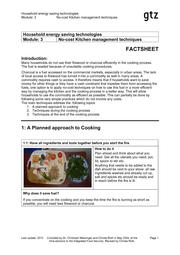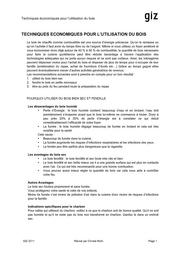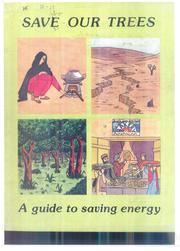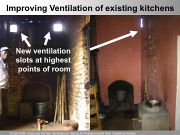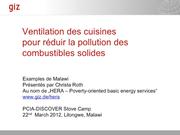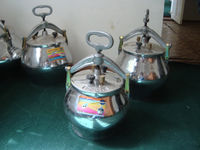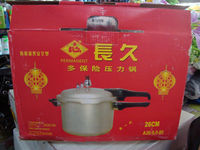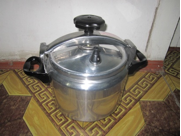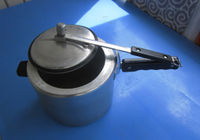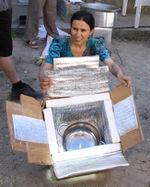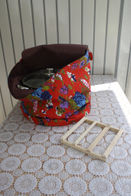Knowledge fuels change
For over a decade, Energypedia has shared free, reliable energy expertise with the world.
We’re now facing a serious funding gap.
Help keep this platform alive — your donation, big or small, truly matters!
Thank you for your support
General Kitchen Management Practices
Basics | Policy Advice | Planning | Designing and Implementing (ICS Supply)| Technologies and Practices | Designing and Implementing (Woodfuel Supply)| Climate Change
Kitchen Management: General Cooking Energy-Saving Practices and Devices
Certain ways of fuel preparation and handling of the stove offer potentials to improve cooking efficiency to reduce the amount of fuels used for cooking and to avoid the exposure to harmful emissions. One option is that users adjust their behaviour and adopt efficient cooking practices. Another option is to integrate energy-saving devices such as pressure cookers or heat retainers into the household cooking system. Hence, an optimal kitchen ventilation allows smoke to leave the kitchen before harming the cooks. These options are described in more details in the following three sections.
Fuel-saving Cooking Practices
Simple changes in the cooking practices of households can save substantial amounts of fuel. The following guidelines, commonly known as 'kitchen management practices' can be applied to save energy while cooking:
Don't waste fuel by running an empty stove
- Get all the ingredients needed for the dish readily prepared (collecting, washing, cutting, etc.) before you start the fire.
- Have all ingredients and utensils at hand close to the stove, including cooking tools, water, and spices.
- Don't waste time once the fire is started and avoid wandering off (e.g. to chat with your neighbour) while the stove is already on.
- Extinguish the fire when you have finished cooking.
Make the best use of the heat from the fire
- Ensure that the heat generated from the fire finds its way into the pot. For instance, shield the pot from wind e.g. with a skirt around the pot to avaid the hot flue gases blown away and the coolingt of the pot by the wind.
- Use a metal pot. It conducts heat better than a clay pot.
- Use a pot with a flat bottom instead of round-shaped pots. The transfer of heat into a flat-bottom pot is higher.
- Reduce the intensity of the fire once the food has come to a boil.
- Use a heat retaining device after boiling.
- Use a lid on the pot to prevent surplus steam from escaping the pot (steam is water heated beyond boiling point, so any steam leaving the pot is energy lost for the cooking process).
- Use small amounts of water for cooking: any water that is thrown away after cooking has consumed a lot of energy until it boiled. This practice not only saves fuel but also retains nutrients.
- Clean soot of your cooking pan.
Shorten cooking times of certain foods
- Soak dried food (such as beans, peas, rice, etc.) prior to cooking.
- Cut food up into smaller pieces: e.g. cut smaller cubes or slices instead of boiling a whole potato or cassava root.
- Don't overcook food. Monitor the cooking process closely by testing regularly if the food is already cooked. Once the food is ready to eat, take it off the stove.
Often the impact of simple behavioural changes is overlooked, or is not known to the project staff or partner organisations. Since most of these practices do not require additional tools or devices, households can save energy at little or no cost.
In addition, efficient cooking practices do not only take place in the kitchen itself, but already start with fuel management.
Further Information
Efficient cooking practices based on experience from Malawi in English and French |
No cost techniques kitchen management practices
|
|
based on experience from Burkina Faso in French |
|
| Mode d'utilisation des foyers améliorés. An instruction to "good practice" and "bad practice" of the stoves for Benin. | |
| Save Our Trees-A guideline to to Saving Energy |
Kitchen Ventilation to Reduce Air Pollution Levels from Cookstove Smoke
This section deals with technologies and techniques that reduce the air pollution and smoke level within a kitchen.
Smoke exposure is influenced by various factors:
- by the fuel used, by the user behavior,
- by the type of cookstove, and
- by the ventilation.
With a 3-stone fire and no or bad ventilations, walls are often black from the floor to the roof, indicating that the kitchen used to be filled entirely with smoke. Not even chimneys are necessarily the solution for smoke removal: the smoke leaves not out of chimney, but out of door and windows. Most chimney- stoves only function well with the pot the stove was designed for, not with a kettle without lip.
If climate allows openings in the wall, simple ventilation slots at highest points of room can guide smoke out in extisting kitchens. Hence, cross-ventilation at the height of peoples nose are as well easily to install and a effective measure to lead smoke out of the kitchen. However, please remember, that ‘Clean’ cooking is not a result of the stove, but from the use of stove.
|
Improving Ventilation of existing kitchens (picture by C. Roth, GIZ) |
For more pictures and information, see presentation below:
|
References |
Links |
|---|---|
|
Kitchen Ventilation to reduce air pollution levels from cookstove smoke: Examples from Malawi. Presentation of Christa Roth, held at PCIA Discover Stove Camp, 22nd of March 2012 in Malawi (English). |
|
|
Ventilation des cuisines pour réduir la pollution des combustibles solides: Examples de Malawi presentés par Christa Roth a PCIA Discover Stove Camp, 22 March 2012 in Malawi (French). |
Energy-Saving Cooking Equipment
Complementary to the use of improved cookstoves or solar cookers, the use of cooking equipment such as pressure cookers or heat retainers allows to save even more energy than with a stove alone.
Pressure Cookers
Pressure cookers are special cooking pots that can be sealed airtight and allow pressure to build up inside. A mechanical device (screws or interlocking parts) presses the pot-lid firmly against the pot-body. A gasket or seal in between the lid and the pot prevents steam to escape from the pot. With rising heat, the steam pressure inside the pot builds up beyond atmospheric pressure, allowing the temperatures to rise well above boiling point. This design enables to save time, energy, and resources. The temperature inside a pressure cooker can well go beyond 110° C, which reduces the time needed to cook food. In addition, very little steam escapes between the pot and the lid, thus requiring less water to cook the food.[1]
So far, pressure cookers have often been overlooked as potential components of efficient integrated cooking systems. They are normally made from thick aluminium or stainless steel, which makes them heavier and more expensive than conventional pots. They might also be difficult to produce in many developing countries. Prices are seldom below 20 US$, top-of-the range products easily exceed 200 US$. In regions, where pressure cookers are not commonly used, the relatively high costs of purchase are an obstacle for their spread out. Pressure cookers are more popular in urban areas, where the fuel has to be paid for in cash, and in regions, where local food can easily be cooked with pressure cookers: especially in Asia (China, Nepal, and India).
Worldwide, different models of pressure cookers are offered on markets. In order to find the most appropriate model, different features have to be taken into consideration, such as price, size, main kind of stove applied (electric, gas, fire), durability, and maintenance. Additionally, the replacement of the seals is an important point to consider. The following pictures show examples of pressure cookers found during a market analysis in Tajikistan in 2010/2011.
Pressure cookers can be used with nearly any stove and fuel type. When used on an open wood-fire, however, care should be taken that non-metal parts do not get exposed to the flames, otherwise they might melt or burn.
Pressure cooker can also be used in combination with a fireless cooker, such as a heat retention bag or box (discussed later). With this type of combination, fuel savings of 80% were measured in a test in Tajikistan carried out with Welthungerhilfe[2]. If the pot is put into a heat retention bag or box before the pressure valve releases steam, no energy in form of steam is lost. Information such as cooking time to boil, cooking time after boil is reached, and time required for the pot to remain in the heat bag are necessary for, e.g, instruction manuals. This information depends on the altitude, food to be cooked, and type of pressure cooker and heat retention bag.
Pressure cookers can also be utilized for cooking traditional cooking recipes. However, user training and awareness training are necessary to show users how to cook traditional recipes on the new equipment. One example of doing this is to handout a pressure cooker cookbook for traditional dishes.
In higher altitudes the low atmospheric pressure reduces the boiling point of water. Therefore the cooking is slower and requires more fuel or food remains undercooked. The required boiling time for softening the food is between one fourth and one fifth of the normal boiling time, depending on the altitude.
As the steam within the pressure cooker creates a higher boiling temperature, the potential of pressure cookers to save fuel and cooking time rises with increasing altitudes, as shown in the following table:[2]
| Altitude in meters | Sea level | 1000 m | 1500 m | 2250 m | 3000 m | Pressure cooker A |
| Boiling temp. degrees Celsius | 100 ºC | 96.6 ºC |
95 ºC | 92.2 ºC |
90 ºC |
118 ºC ~ 120 ºC |
Advantages of Pressure Cookers
- Pressure cookers can be used with most fuel types and stoves.
- At high altitudes where the boiling point is lower, they offer great advantages to raise the temperature above 100°C and prevent food from being left undercooked.
- Cooking is much faster and thus the pressure cooker can save considerable amounts of time and energy.
- It is possible to sterilise goods using a pressure cooker.
- Nutrients and flavors are retained: Because foods cook quickly with a small amount of liquid in an almost airless environment, vitamins and minerals that are normally boiled away in the cooking process condense in the pot and absorb back into the food retaining the precious nutrients naturally found in our food.[3][4]
Disadvantages of Pressure Cookers
- More expensive than normal pots.
- As steam builds up inside, they cannot be used for frying or roasting.
- Can not be used for foods that need to be stirred during cooking (like maize porridge).
- Opening the cooker must be done carefully since hot steam, under pressure, can escape with force and scald the cook.
- Pressure cookers are not appropriate for dishes, where different ingredients need to be added at different times, as they cannot easily be opened during cooking.
- Seal between the pot and the lid wears out and must be replaced; thus a service system has to be in place.
- Cooking with a pressure cooker requires the change of accustomed cooking processes (behaviour change).
- Due to the hotter steam the risk of scalding is higher.[5]
Safety Aspects
If appropriately used and maintained, pressure cookers are safe to use. However, several important considerations should be kept in mind. To prevent explosions, regulators and safety valves let surplus pressure escape. It is really important that the safety valve and regulator are fully functional. Pressure cookers should never be filled until the top of the pot, as the regulator and the valve can get blocked easily. In case of too high pressure the steam can abruptly escape, which can lead to scalding. In addition, pressure cookers made from aluminium should not be cleaned with sharp items or with soda, as afterwards aluminium can enter the food, which will cause diseases.
Unfortunately, if the pressure cooker is poorly maintained or inappropriate used, the cooker can explode, which can result in serious injuries.[6][2]
Further Information
- Everything about pressure cookers: Pressure-Cooking Times & Instructions: fastcooking.ca - pressure cookers
http://discoverpressurecooking.com/index.html
- Manual on Pressure Cookers (*Russian): Manual PRESSURECOOKER
References
- ↑ http://en.wikipedia.org/w/index.php?title=Pressure_cooking&redirect=no#Science_of_pressure_cooking
- ↑ 2.0 2.1 2.2 HEDON, Pressure Cooker Training, issue 57 - 2009. http://www.hedon.info/BP57_PressureCookerTraining?bl=y
- ↑ http://en.wikipedia.org/w/index.php?title=Pressure_cooking&redirect=no#Advantages
- ↑ http://discoverpressurecooking.com/advantages.html
- ↑ http://en.wikipedia.org/w/index.php?title=Pressure_cooking&redirect=no#Disadvantages
- ↑ http://en.wikipedia.org/w/index.php?title=Pressure_cooking&redirect=no#Safety_features
Heat Retainers: Keep cool, stay hot
Retaining heat is a good way to delink the time of food preparation and the time of food consumption. This is especially helpful to complement a fuel that is not available on demand like solar energy. It allows having hot food even after sunset, when sunlight is not available to cook.
Heat retainers cannot substitute a stove, but they can be used to complement any stove and any fuel. In order to retain heat for cooking, heat needs to be generated first. By combining the heat retaining devices with other energy-efficient technologies (pressure cookers, solar stoves, improved cook stoves) or practices, it can contribute to reducing the fuel consumption considerably.
Depending on the material used, heat retainers can be as well used for cooling.
Thermos Flasks
Thermos flasks are an inexpensive way to maintain the heat of water, beverages or liquid foods like soup and porridge over time. In places, where food preparation is based on pouring hot water over food items such as in Tibet, thermos flasks save fuel and enhance cooking comfort. Alongside solar cookers, families own up to five thermos flasks and store the water heated by the solar cooker during the day. The hot water is used for preparing both morning and evening meals (mainly soup and porridge) enabling the solar cooker to satisfy almost all household energy needs. However, this represents a rather specific case, which may not be transferable to many other countries.[1] Yet, thermos flasks are currently underutilized and could probably play a more important role. When promoting the use of thermos flasks, features concerning price, durability, cleaning, size and material (toxic) have to be also considered.
Fireless Cookers
In some parts of the world, the concept of the fireless cooker has been known about for centuries. It became popular in the western world in the years between the 1890s and the 1930s. Initially, the heat retention cooker was mainly used to make food more portable for use by people on the move such as fishermen, hunters and soldiers. However, during the first decades of the twentieth century, the fireless cooker also became a permanent fixture of many American and European households, an appliance often found next to the cooking stove. Nowadays, it is mainly promoted in developing countries.[2]
Other names are: heat retention box, heat retention bag, heat retention cookers, hay box, hot bag, food warmer.
Principle of Fireless Cookers
The fuel consumption during the cooking process is not constant. A lot of fuel is required to heat up the content of a cooking pot to boil. However, once it is boiling, it only takes little energy to keep it hot and maintain the temperature at boiling point.
Cooking with heat retention boxes or bags means that food is brought to a boil, simmered for a few minutes depending on the particle size and then put into the fireless cooker to continue cooking. Since the insulated cooker prevents most of the heat in the food from escaping into the environment, no additional energy is needed to complete the cooking process.[3] This is why this is called 'fireless cooking'.
Construction and functionality of the heat retention box (fireless cooker, hay box, hot bag etc.) depend on the insulative properties of the material used. The underlying principle of insulation is that air does not conduct heat. The more insulated pockets of air you can create between the cooking pot and the outside, the more heat will be retained inside the pot. Insulative materials are almost everywhere available. For example organic residues such as hay, sawdust, cotton waste, or dried leaves, e.g. from banana plants can be used. Other materials are waste paper, polystyrene beads, or vermiculite. An insulated lid or cushion closes the box or bag.[4]
Depending on the type of stove used for boiling, food cooked and traditional cooking practices, using heat retention bags can reduce fuelwood consumption to a great extent. According to a test of The Partnership for Clean Indoor Air (PCIA) the energy savings of fireless cookers combined with different stove types amount to an average fuel reduction of 50%.[5] Some people report that they can save up to 80% of their fuel, depending on the food and the efficiency of the insulation.
Especially for food that do not require any stirring, e.g. (sweet) potatoes, meat, cassava or rice etc., fireless cookers are very suitable. Food can be kept warm for up to 6 hours, e.g. for people who return home late from the field or the market and want their children to find hot food when they come back home from school.
Advantages of Fireless Cookers
- Slow cooking retains many more of the food’s nutrients and vitamins than if prepared on a constantly hot fire.
- Food can be kept warm for a long time.
- Fuel savings.
- Food cannot burn.
- Women are less exposed to smoke.
- Food can be left unattended in the hot bag, leaving women more time for other activities.
- Women can reduce the frequency of cooking by preparing enough food for two meals and putting half of it in the hay box to keep warm.
- Depending on the material used, heat retainers can be as well used for cooling.
- Heat retention bags and boxes can be made with almost no costs or purchased for little money.[3][6]
Disadvantages of Fireless Cookers
- The technology is not applicable to all types of food; it is limited to dishes that are cooked slowly in liquid (beans, rice, meat etc.).
- If you open the lid of the pot and stir the content, the temperature goes down quickly and might go below the point where the food still cooks.
- Change of taste: if beans are prepared in a fireless cooker, they don't acquire the smoky taste as if they were cooked on a fire for long hours. They might be healthier, but they taste different and are sometimes rejected for that reason.
- It is not advisable to keep the food warm longer than six hours. Otherwise it might promote the growth of microorganisms in the food which puts the health at risk.
- In case the pot is used on open fire, people might refuse to put the black pot into the box or bag, in order not to soil it
- Cooking with a heat retention bag or box requires changing accustomed cooking processes. In order to show people the advantages of the heat retention box or bag cooking demonstrations, cooking books, etc. might be required.[7]
Examples of Using Fireless Cookers
Heat retention boxes/bags have been successfully introduced for taking care of sick people in Malawi. Patients often cannot eat one big meal but have to eat or drink small portions of food or tea many times throughout the day and night. Without a fireless cooker, this would require frequent food preparation. In a retained heat cooker, food can be kept warm near the bed of a sick person who can take hot food or tea at a time of his convenience for a period of 3-4 hours. This has particular relevance for taking care of HIV/AIDS patients.[8]
Promoting Heat Retention Boxes or Bags?
As a project, if deciding between the introduction of a heat retention box or a bag, the following points could be helpful:
| Heat retention box |
Heat retention bag |
|---|---|
| Easier to keep clean | Material easily available and cheap, but difficult to wash or clean |
| Not adaptable to different pot sizes | Adoptable to different pot sizes |
| Higher transport costs |
Less space required for transportation, lower transportation costs |
| Higher production costs (material, labor) |
Lower production costs (material, labour) |
| Source for income generation | Source for income generation |
| Cooled items can be stored cool in the box. | When reflective foil is used, the reversed bag can be used for cooling |
| Usable as seat, in case box is robust | Few space required for packing away |
| First model of a heat retention box made from cardboard box, polystyrene, and reflective insulative foil in Tajikistan Picture: Heike Volkmer |
Heat retention bag with trivet promoted in Tajikistan Picture: Friederike Müller |
Further Information
Manuals, reports and other articles:
- Retained heat cooker: "Fireless cooker" or "Foodwarmer" by Christa Roth (2010).
An illustrated step-by-step description from Malawi showing how to build a food warmer/fireless cooker using a basket, cloth and dried banana leaves. Two recipes for local dishes are included. It is a very helpful document. - How to make a Heat Retention Box by Sjoerd Nienhuys, published in Boiling Point Issue 62 (2014) on Heat Retention Boxes for use in Himalayan regions.
- Construction manual of a heat retention bag – experience from Tajikistan and Pakistan (English). Technical Working Paper, Number 20a, 2011.
- Guide to Designing Retained Heat Cookers by Don O'Neil / HELPS International / PCIA (2007).
- Hot bag – Cooking with retained heat and recipes from South Africa. See also http://www.afreca.org
- Performance Test of WonderBag - A Pathway to Reduce Cooking Energy Consumption and CO2 Emission (2014).
Different Bangladeshi foods were cooked with the WonderBag to assess potential fuel savings. - Marketing material for promoting heat retention bags in Tajikistan through a retailer cooperative (Russian).
- Cooking book for using the heat retention bag for traditional dishes in Tajikistan (Russian).
- Heat retention product explanation with guidance on cooking times for special dishes from Tajikistan (Russian).
- a fireless cooker.pdf?dl=0?dl=1 Make a Fireless Cooker. By: Pan Africa Conservation Education.
This step-by step instruction for building a fireless cooker is supplemented with background information on the cooker and its use. The homepage of PACE provides a number of other helpful documents on resource protection at grassroots level. - The role of biomass energy conservation for HIV mitigation. Presentation by Christa Roth /ProBEC (2006).
- Engaging communities in alleviating smoke –what the real experts tell you. By Vincent Okello (2009).
Experience from Kenya introducing the fireless cookers to women. - Heat Retention Cooking vs. Solar Cooking by Mike Bridgewater.
Useful websites:
- solarcooking.wikia. - Integrated_Cooking_Method
The website provides information on integrated cooking methods. - solarcooking.org - heat-retention/
Information on making a hay box and cooking practices with cooking times, etc. - www.bioenergylists.org
References to examples on retained heat cooking from Bolivia. - cookinginabasket.blogspot.com
References to examples on retained heat cooking from Kenya. - www.sunseedtanzania.org
Information on “wonder baskets” introduced in Tanzania. - www.hotbag.co.za
The Hotbag Project. Information about cooking methods and times, recipes, and products to buy. - www.afreca.org
Commercial website selling heat retention bags.
References
- ↑ GTZ HERA (2007): Here Comes the Sun. Options for Using Solar Cookers in Developing Countries.
- ↑ f We Insulate Our Houses, Why Not Our Cooking Pots? In: Low-Tech Magazine, July 1, 2014. http://www.lowtechmagazine.com/2014/07/cooking-pot-insulation-key-to-sustainable-cooking.html
- ↑ 3.0 3.1 Heat retention cooking. http://solarcooking.wikia.com/wiki/Heat-retention_cooking Cite error: Invalid
<ref>tag; name "Heat retention cooking. http://solarcooking.wikia.com/wiki/Heat-retention_cooking" defined multiple times with different content - ↑ GTZ (2010): Retained heat cooker. energypedia.info/images/0/00/GTZ_4a_FS_fireless_cooker_2010.pdf
- ↑ Partnership for Clean Indoor Air (PCIA) (2012): Test Results of Cook Stove Performance. http://my.ewb-usa.org/theme/library/myewb-usa/project-resources/technical/TestResultsCookstovePerformance.pdf
- ↑ Including experiences made by Christa Roth in Malawi.
- ↑ Based on experiences made by Christa Roth in Malawi.
- ↑ Christ Roth (2006): The role of biomass energy conservation for HIV mitigation
References
This article was originally published by GIZ HERA. It is basically based on experiences, lessons learned and information gathered by GIZ cook stove projects. You can find more information about the authors and experts of the original “Cooking Energy Compendium” in the Imprint.


